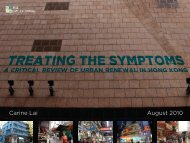Untitled - Civic Exchange
Untitled - Civic Exchange
Untitled - Civic Exchange
You also want an ePaper? Increase the reach of your titles
YUMPU automatically turns print PDFs into web optimized ePapers that Google loves.
SUSTAINABLE TRANSPORT IN HONG KONG: DIRECTIONS AND OPPORTUNITIES<br />
Table 7.2<br />
Committed and planned rail projects in Hong Kong<br />
Committed<br />
Projects<br />
Length<br />
(km)<br />
Scheduled<br />
completion date<br />
Project cost<br />
(HK$billion)<br />
West Rail Phase I<br />
Tseung Kwan O Extension<br />
Ma On Shan Rail<br />
Tsim Sha Tsui Extension<br />
Sheung Shui to Lok Ma Chau Line<br />
Penny's Bay Link<br />
30.5<br />
12.5<br />
11.4<br />
1<br />
7.4<br />
3.5<br />
End-2004<br />
Mid-2002<br />
2004<br />
2004<br />
2004<br />
2005<br />
51.7<br />
24<br />
16.3<br />
2<br />
8.5<br />
2.6<br />
Planned<br />
Projects<br />
Indicated<br />
completion<br />
Estimated<br />
cost<br />
Shatin to Central Link<br />
Island Line Extension to Western<br />
Kowloon Southern Link<br />
Northern Link<br />
Regional Express Line<br />
Port Rail Line<br />
2008-2011<br />
2008-2012<br />
2008-2013<br />
2008-2016<br />
*<br />
*<br />
27-37<br />
19-20<br />
7-8<br />
9<br />
13-17<br />
5-9<br />
* Dependent on cross-border traffic growth.<br />
Current rail financing mechanism<br />
The major rail operator, the Mass Transit Railway (MTR) Corporation is financed 80% by fares, 10% by<br />
property development rights around its stations, and 10% by miscellaneous sources, such as shop rentals<br />
in stations and advertising. The passenger rail systems in Hong Kong do not receive any direct government<br />
grants to help meet expenses. Therefore, the MTR Corporation can only build a new rail line when<br />
population densities are sufficient to ensure the commercial viability of the line from day one.<br />
In contrast, in other cities around the world, direct government grants play a major role in meeting the<br />
construction cost of new rail lines and, to a lesser degree, in meeting capital equipment and operating<br />
costs. 263 Such support is provided in recognition of the positive external (un-priced) benefits provided by<br />
off-road mass transit (less road congestion; faster, more predictable travel times; reduced air pollution and<br />
noise; and less loss of land for roads and their setbacks). Hong Kong appears to be a rare, and probably<br />
unique, case in the sense that its two passenger rail service providers are nearly self-financing.<br />
However, at all layers of government, policy-makers see the existence of rail subsidies in other parts of the<br />
world as evidence of the failure of those systems. 264 This belief seems to have clouded clear thinking on<br />
the issue of rail financing and prevented an examination of how Hong Kong could expand rail to serve the<br />
greatest possible number of people in a cost-effective manner (see Case Study 2 below).<br />
82<br />
263 Barron, W., Ng S., and Kwok, V. (2001), Financing Urban Passenger Rail: An International Survey, Hong<br />
Kong: Centre of Urban Planning & Environmental Management, University of Hong Kong.<br />
264 Rail systems in cities such as London and New York suffer from under-investment and are poorly maintained<br />
when compared to Hong Kong's newer rail system, but this should not be confused with the issue of the<br />
extensiveness of their networks.

















